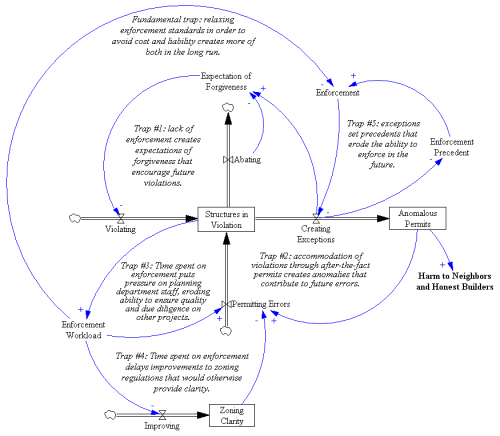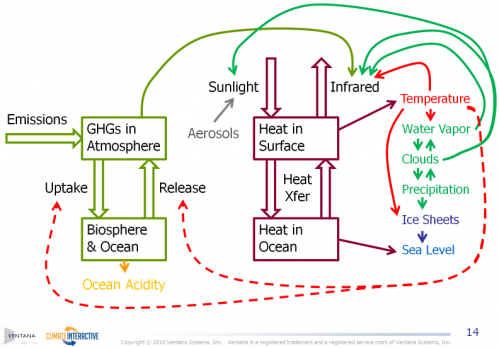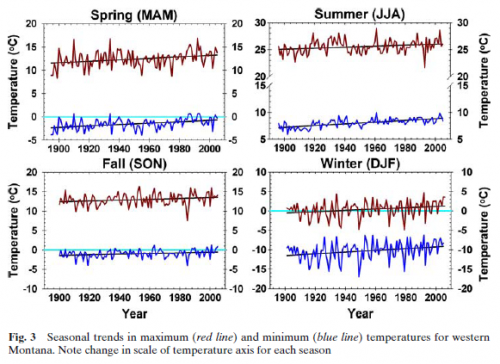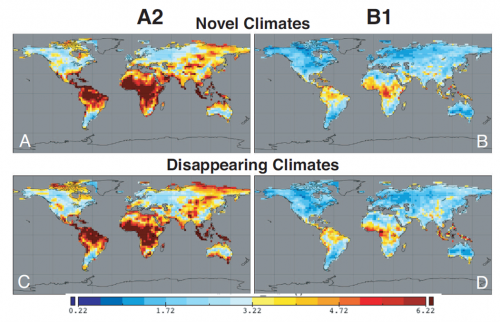No time to write anything lately, so here’s a pic of an elk thistle, in a rocky chute at almost 10,000 feet in Beehive Basin, near Big Sky, MT. In 1870, Truman Everts was lost in Yellowstone for 37 days, and survived largely by eating these.
Category: Montana
Gallatin County's Zoning Enforcement Trap
I’m playing a big role in a local effort to get the regulations of our zoning district enforced in the case of an egregious violation. Our planning and zoning commission’s habit, and apparent preference in this case, is not to enforce. Instead, it is proposed to enable the violation through a PUD amendment, and issue a trivial fine ($200, or 0.2% of the stated value of the structure).
Unfortunately, this proposal is illegal, because it contradicts existing covenants and a variety of goals and specific provisions of our General Plan and Zoning Regulation. This action might make sense if it were a naked political ploy to undermine the zoning through administrative rather than legislative means, which I hope is not the case. I think it is more likely an effort to “play nice” with violators and to avoid costly enforcement action.
If so, the resulting weak enforcement posture is a short-sighted avoidance of conflict, that encourages far more problems in the long run. As the diagram below illustrates, backing down on the case at hand solves the immediate problem, but has terrible consequences.
- The precedent for non-enforcement and amendments to legalize violations erodes the legal basis for future enforcement actions.
- Accommodation creates an expectation of forgiveness, encouraging owners and builders to violate in the future.
- Exceptions created to accommodate violations make planning documents and title histories more complex, creating more opportunities for errors.
These side effects of lax enforcement accumulate. As violations mount, time that could be spent on productive activity (ensuring a thorough permitting process, or revising zoning regulations to clarify standards and streamline processes) gets squeezed out by time wasted on enforcement.
These reinforcing feedbacks create a deadly trap, into which the unsuspecting can easily step. Once triggered, the vicious cycle creates more pressure to relax enforcement standards, capturing the county in an undesirable equilibrium with many violations and no meaningful enforcement. Ultimately, the citizens (who initiated the zoning district) suffer from the side effects of density granted to violators, that is unavailable to those who comply with the law.
Fortunately, with a little fortitude, the process can be reversed. A single forceful enforcement action has a salutary effect on expectations, stemming the tide of violations and freeing up time for the improvement of regulations. There’s still the hangover of side effects of past accommodation to contend with, but surely the withdrawal is better than the addiction to accommodation.
Hatchetations, interrupted
The temperance movement may have won the prohibition war (temporarily), but a minor battle was lost just down the road from here, in Butte.
Despite the reformers’ best efforts, Butte’s demimonde was larger and seedier than ever by 1910. That year the federal census recorded Butte’s highly transient population at more than 39,000 and enumerated more than 250 prostitutes. In 1910 when temperance crusader Carrie Nation came to Butte, “booze joints” in nearby Anaconda sported signs that read: “All Nations Are Welcome Except Carrie.” Butte’s morally upright citizens, who had invited Nation, welcomed her with open arms, yet her performance failed to match their expectations. With a flourish and a crowd in tow, the stout sixty-three-year-old Nation charged down the length of Pleasant Alley. Once back on Mercury Street, she stormed into the Irish World, where she met her match in madam May Maloy. The two women joined in a scuffle, and Nation emerged the obvious loser. It was a moment savored by May’s patrons and celebrated with drinks all around. – Ellen Baumler, Montana Historical Society
Nation died 6 months later.
The Law of Attraction
No, not that silly one.
Controlling Growth by Controlling Attractiveness
In Woodstock, Vermont, everyone’s mad about a highway. In other places the issue is a sewer system or a school. The real issue, of course, is growth. According to Jay Forrester’s Attractiveness Principle (Forrester is a professor of systems analysis at MIT) there’s only one way to control growth — control attractiveness.
…
In a free society if any place is unusually attractive, folks will — no surprise — be attracted there. The most mobile people (the young, the rich, the educated) will get there first. The place will grow until its attractiveness has been reduced by crowded highways, or unemployment, or scarce housing, or pollution, or just plain visual blight. (The most mobile people have moved on by then). When the place is no more attractive than anywhere else, then and only then will it stop growing. What else can stop it?
…
The attractiveness of a place is a complex combination of climate, economy, amenities, scenery. No one can define attractiveness exactly, but people make up their minds about it every day by deciding to move from Hartford or Boston or Westchester County to Vermont (that’s the direction they’re moving at the moment). Millions of human judgements weigh Vermont’s clean air against Boston’s job market and Manhattan’s cost of living. The very different mixes of attractiveness and unattractiveness in those places may seem incommensurable, but people make their comparisons, and eventually attractiveness evens out everywhere.
…
The normal instinct of public officials, including those of Woodstock, is to fix problems and make their community perfect. The more perfect they make it, the more new people show up. What Woodstock needs to do, Forrester would say, is decide what kinds of imperfection it’s willing to live with.
A crowded, unsafe highway? If that’s unacceptable, then choose something else. Super-restrictive zoning, perhaps, or an absolute limit on new curb cuts, or higher property taxes (I know, they’re already too high, but not high enough to stop people from moving in). Bad schools. Bad air. No jobs. Developments so ugly you might as well live in New Jersey. Some sort of whopping surcharge on those developers. Either Woodstock chooses its form of unattractiveness, or the growth process itself chooses.
It takes awhile to absorb the implications of the Attractiveness Principle, because it turns conventional thinking upside down (Forrester is good at doing that). Its implications are not good news for the sort of people who live in Woodstock. The Principle says you can’t live in a privileged bubble of attractiveness, unless you are perpetually young, rich, educated, and on the move at the head of the attractiveness wave. It says that growth is your problem wherever it occurs. It says the only way to be sure of living in an attractive place is to be committed to the attractiveness of every place.
From the Donella Meadows Archive
Hail of a day
Spring in Montana
I woke up to find it raining on the west side of the house, and snowing on the east. Globally it may be warm, but not here in Bozeman.
That’s a glacier lily in the snow. They’re so abundant right now that it’s hard to walk in the woods without stepping on one.
Climate Science, Climate Policy and Montana
Last night I gave a climate talk at the Museum of the Rockies here in Bozeman, organized by Cherilyn DeVries and sponsored by United Methodist. It was a lot of fun – we had a terrific discussion at the end, and the museum’s monster projector was addictive for running C-LEARN live. Thanks to everyone who helped to make it happen. My next challenge is to do this for young kids.
My slides are here as a PowerPoint show: Climate Science, Climate Policy & Montana (better because it includes some animated builds) or PDF: Climate Science, Climate Policy & Montana (PDF)
Some related resources:
Climate Interactive & the online C-LEARN model
Montana Climate Change Advisory Committee
Montana emissions inventory & forecast visualization (click through the graphic):
Montana's climate future
A selection of data and projections on past and future climate in Montana:
Pederson et al. (2010) A century of climate and ecosystem change in Western Montana: what do temperature trends portend? Climatic Change 98:133-154. It’s hard to read precisely off the graph, but there have been significant increases in maximum and minimum temperatures, with the greatest increases in the minimums and in winter – exactly what you’d expect from a change in radiative properties. As a result the daily temperature range has shrunk slightly and there are fewer below freezing and below zero days. That last metric is critical, because it’s the severe cold that controls many forest pests. There’s much more on this in a poster.
Not every station shows a trend – the figure above contrasts Bozeman (purple, strong trend) with West Yellowstone (orange, flat). The Bozeman trend is probably not an urban heat island effect – surfacestations.org thinks it’s a good site, and White Sulphur (a nice sleepy town up the road a piece) is about the same. The red line is an ensemble of simulations (GISS, CCSM & ECHAM5) from climexp.knmi.nl, projected into the future with A1B forcings (i.e., a fairly high emissions trajectory). I interpolated the data to latitude 47.6, longitude -110.9 (roughly my house, near Bozeman). Simulated temperature rises about 4C, while precipitation (green) is almost unmoved. If that came true, Montana’s future climate might be a lot like current central Utah.
The figure above – from John W. Williams, Stephen T. Jackson, and John E. Kutzbach. Projected distributions of novel and disappearing climates by 2100 AD. PNAS, vol. 104 no. 14 – shows global grid points that have no neighbors within 500km that now have a climate like what the future might bring. In panel C (disappearing climates with the high emissions A2 scenario), there’s a hotspot right over Montana. Presumably that’s loss of today’s high altitude ecosystems. As it warms up, climate zones move uphill, but at the top of mountains there’s nowhere to go. That’s why pikas may be in trouble.
The Rygg study, pining for the fjords
The DEQ dead parrot skit continues in the Revised Evans EA, which borrows boilerplate from the Morgan EA I reported on yesterday. It once again cites the spurious Rygg study, overgeneralizes its findings, and repeats the unsubstantiated Fairbanks claims. At least in the Morgan EA, DEQ reviewed some alternative evidence cited by Orville Bach, indicating that gravel pit effects on property values are nonzero. In the Evans EA, DEQ omits any review of evidence contradicting Rygg; evidently DEQ’s institutional memory lasts less than 3 months.
Even the review in the Morgan EA was less than coherent. After discussing Rygg, they summarize Bach’s findings and two key articles:
He includes a figure from one of the citations showing the impact on residential property values based on distance of the property from the gravel mine – the closer the property, the greater the impact. Based on this figure, properties less than a quarter mile from the mine experienced up to a 32% decline in value. The impact on property value declined with increased distance from the gravel mine. Properties three miles away (the farthest distance in the analysis) experienced a 5% decline. …
Researchers have used the hedonic estimation method to evaluate impacts to housing prices from environmental “disamenities” (factors considered undesirable). Using this multivariate statistical approach, many characteristics of a purchased good (house) are regressed on the observed price, and thus, one can extract the relative contribution of the environmental variables to the price of the house (Boyle and Kiel 2001). Research has been conducted in many locations in the country, and on many types of disamenities (landfills, power plants, substations, hazardous waste sites, gravel mines, etc.). The study cited by Mr. Bach (Erickcek 2006) uses techniques and data developed by Dr. Hite to evaluate potential effects on property values of a proposed gravel mine in Richland Township, Michigan. Dr. Hite’s study evaluated effects of a gravel mine in Ohio. Both the Erickcek and Hite studies showed decreases in property values resulting from proximity of the property to the mine (Erickcek 2006).
DEQ latches onto one footnote in Erickcek,
However, Erickcek states in footnote 6, ‘Only those owning property at the time of the establishment of the gravel mine would experience a loss in equity. Those purchasing property near an established mine would not experience an equity loss because any negative effects from the mine’s operation would have been incorporated into the purchase price.’
Note that this is a statement about property rights and the distribution of harm. It doesn’t in anyway diminish the existence of harm to someone in society. Evidently DEQ doesn’t understand this distinction, or thinks that Rygg trumps Hite/Erickcek, because it concludes:
Irreversible and Irretrievable Commitments of Resources: The Proposed Action would not result in any irreversible or irretrievable commitments of resources related to the area’s social and economic circumstances.
Could Rygg trump Hite? Let’s consider the score:
| Attribute | Rygg | Hite |
| sampling | ad hoc | census |
| sample size | 6+25 | 2812 |
| selection bias | severe | minimal |
| control for home attributes | ad hoc | 4 attributes |
| control for distance | no | yes |
| control for sale date | no | yes |
| statistical methods | none | proper |
| pit sites | 1 | multiple |
| reported diagnostics | no | yes |
| Montana? | yes | no |
That’s Hite 9, Rygg 1. Rygg’s point is scored on location, which goes to applicability of the results to Montana. This is a hollow victory, because Rygg himself acknowledges in his report that his results are not generalizable, because they rely on the unique circumstances of the single small pit under study (particularly its expected temporary operation). DEQ fails to note this in the Evans and Morgan EAs. It’s hard to judge generalizability of the Hite study, because I don’t know anything about local conditions in Ohio. However, it is corroborated by a Rivers Unlimeted hedonic estimate with a different sample.
A simple combination of Rygg and Hite measurements would weight the two (inversely) by their respective variances. A linear regression of the attributes in Rygg indicates that gravel pits contribute positively to value (ha ha) but with a mean effect of $9,000 +/- $16,000. That, and the fact that the comparable properties have much lower variance than subject properties adjacent to the pit should put up red flags immediately, but we’ll go with it. There’s no way to relate Rygg’s result to distance from the pit, because it’s not coded in the data, but let’s assume half a mile. In that case, the roughly comparable effect in Hite is about -$74,000 +/- $11,000. Since the near-pit price means are similar in Hite and Rygg, and the Rygg variance is more than twice as large, we could combine these to yield a meta measurement of about 2/3 Hite + 1/3 Rygg, for a loss of $46,000 per property within half a mile of a pit (more than 30% of value). That would be more than fair to Rygg, because we haven’t accounted for the overwhelming probability of systematic error due to selection bias, and we’re ignoring all the other literature on valuation of similar nuisances. This is all a bit notional, but makes it clear that it’s an awfully long way from any sensible assessment of Rygg vs. Hite to DEQ’s finding of “no effect.”
Montana DEQ – rocks in its head?
Lost socks are a perpetual problem around here. A few years back, the kids would come to me for help, and I’d reflexively ask, “well, did you actually go into your room and look in the sock drawer?” Too often, he answer was “uh, no,” and I’d find myself explaining that it wasn’t very meaningful to not find something when you haven’t looked properly. Fortunately those days are over at our house. Unfortunately, Montana’s Department of Environmental Quality (DEQ) insists on reliving them every time someone applies for a gravel mining permit.
Montana’s constitution guarantees the right to a clean and healthful environment, with language that was the strongest of its kind in the nation at the time it was written. [*] Therefore you’d think that DEQ would be an effective watchdog, but the Opencut Mining Program’s motto seems to be “see no evil.” In a number of Environmental Assessments of gravel mining applications, DEQ cites the Rygg Study (resist the pun) to defend the notion – absurd on its face – that gravel pits have no impact on adjacent property values. For example:
Several years ago, DEQ contracted a study to determine “whether the existence of a gravel pit and gravel operation impacts the value of surrounding real property.” The study (Rygg, February 1998) involved some residential property near two gravel operations in the Flathead Valley. Rygg concluded that the above-described mitigating measures were effective in preventing decrease in taxable value of those lands surrounding the gravel pits.
The study didn’t even evaluate mitigating measures, but that’s the least of what’s wrong (read on). Whenever Rygg comes up,the “Fairbanks review” is not far behind. It’s presented like a formal peer review, but the title actually just means, “some dude at the DOR named Fairbanks read this, liked it, and added his own unsubstantiated platitudes to the mix.” The substance of the review is one paragraph:
“In the course of responding to valuation challenges of ad valorem tax appraisals, your reviewer has encountered similar arguments from Missoula County taxpayers regarding the presumed negative influence of gravel pits, BPA power lines, neighborhood character change, and traffic and other nuisances. In virtually ALL cases, negative value impacts were not measurable. Potential purchasers accept newly created minor nuisances that long-time residents consider value diminishing.”
First, we have no citations to back up these anecdotes. They could simply mean that the Department of Revenue arbitrarily denies requests for tax relief on these bases, because it can. Second, the boiled frog syndrome variant, that new purchasers happily accept what distresses long-term residents, is utterly unfounded. The DEQ even adds its own speculation:
The proposed Keller mine and crushing facility and other operations in the area … create the possibility of reducing the attractiveness of home sites to potential homebuyers seeking a quiet, rural/residential type of living environment. These operations could also affect the marketability of existing homes, and therefore cause a reduction in the number of interested buyers and may reduce the number of offers on properties for sale. This reduction in property turnover could lead to a loss in realtors’ fees, but should not have any long-term effect on taxable value of property. …
Never mind slaves to defunct economists, DEQ hasn’t even figured out supply and demand.
When GOMAG (a local action group responding to an explosion of gravel mining applications) pointed me to these citations, I took a look at the Rygg Study. At the time, I was working on the RLI, and well versed in property valuation methods. What I found was not pretty. I’m sure the study was executed with the best of intentions, but it uses methods that are better suited to issuing a loan in a bubble runup than to measuring anything of import. In my review I found the following:
’¢ The Rygg study contains multiple technical problems that preclude its use as a valid measurement of property value effects, including:
o The method of selection of comparable properties is not documented and is subject to selection bias, exacerbated by the small sample
o The study neglects adverse economic impacts from land that remains undeveloped
o The measure of value used by the study, price per square foot, is incomplete and yields results that are contradicted by absolute prices
o Valuation adjustments are not fully documented and appear to be ad hoc
o The study does not use accepted statistical methods or make any reference to the uncertainty in conclusions
o Prices are not adjusted for broad market appreciation or inflation, though it spans considerable time
o The study does not properly account for the history of operation of the pit’¢ The Fairbanks review fails to consider the technical content of the Rygg study in any detail, and adds general conclusions that are unsupported by the Rygg study, data, original analysis, or citation.
’¢ Citations of the Rygg study and the Fairbanks review in environmental assessments improperly exaggerate and generalize from its conclusions.
I submitted my findings to DEQ in a long memo, during the public comment period on two gravel applications. You’d think that, in a rational world, it would provoke one of two reactions: “oops, we’d better quit citing that rubbish” or, “the review is incorrect, and Rygg is actually valid, for the following technical reasons ….” Instead, DEQ writes,
The Rygg report is not outdated. It is factual data. The Diane Hite 2006 report upon which several of the other studies were based, used 10 year old data from the mid-1990’s. Many things, often temporary, affect property sale prices.
Huh? They’ve neatly tackled a strawdog (“outdated”) while sidestepping all of the substantive issues. What exactly does “factual data” mean anyway? It seems that DEQ is even confused about the difference between data and analysis. Nevertheless, they are happy to proceed with a recitation of Rygg and Fairbanks, in support of a finding of no “irreversible or irretrievable commitments of resources related to the area’s social and economic circumstances.”
So much for the watchdog. Where DEQ ought to be defending citizens’ constitutional rights, it seems bent on sticking its head in the sand. Its attempts to refute the common sense idea, that no one wants to live next to a gravel pit, with not-even-statistical sleight of hand grow more grotesque with each EA. I find this behavior baffling. DEQ is always quick to point out that they don’t have statutory authority to consider property values when reviewing applications, so why can’t they at least conduct an honest discussion of economic impacts? Do they feel honor-bound to defend a study they’ve cited for a decade? Are they afraid the legislature will cut off their head if they stick their neck out? Are they just chicken?











